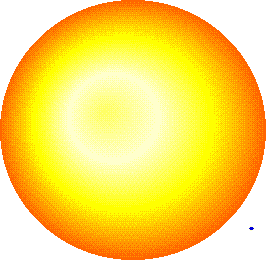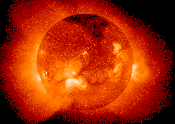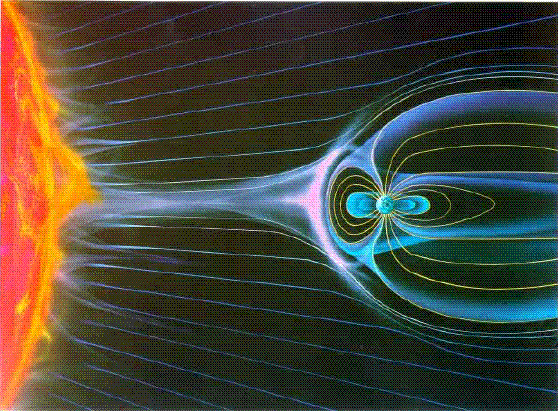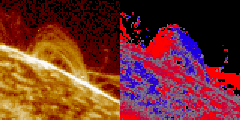Back to Index
Spacecraft Shed New Light on The Sun
|
Michael Gallagher
September 1998
Our knowledge of the Sun has been expanded remarkably by data sent back
by a fleet of spacecraft solar observatories.
Earth orbits the Sun along a nearly circular path 150 million kilometers in
radius. The Sun provides the heat and light that energises the Earth's
weather and ecosystems.
The Sun is a restless, fiery sphere of gas, 109 Earth diameters
across with a volume a million times that of Earth's.
|

Comparative sizes of the Sun and Earth
|
|
 Deep in the Sun's interior, the nuclear fusion of hydrogen occurs on an immense
scale. A massive amount of energy is generated and is radiated into space at
all wavelengths.
Deep in the Sun's interior, the nuclear fusion of hydrogen occurs on an immense
scale. A massive amount of energy is generated and is radiated into space at
all wavelengths.
|

X-Ray image of the Sun
taken by the Yohkoh satellite
|

From a video sequence taken by the SOHO satellite
|
To the eye, the Sun appears to have a steady surface. The SOHO satellite,
permanently parked between the Earth and the Sun, shows
the real picture. The Sun's surface is in constant motion, stirred by the
heat rising from its fusion reactor core.
|
|
A stream of gas known as the solar wind is constantly puffed out by the Sun. It moves
out through the solar system, engulfing the Earth and the other planets. The Ulysses
spacecraft, now on its second orbit over the Sun's polar regions, has gathered
much new data about the makeup of the solar wind.

Artist's impression of how the solar wind interacts with the Earth's
magnetic field
|

Ultraviolet image taken by the Solar Maximum satellite.
In the right-hand image, the line-of-sight velocity is color coded.
Approaching material is blue and receding material is red.
|

Large, eruptive prominence
June 15 1998 at 07:19 UT [SOHO]
Click for full size image.
|
Periodically the Sun hurls great arches of gas up into its outer atmosphere. At times massive
bubbles of gas weighing billions of tonnes (the weight of 100,000 battle ships)
are ejected into surrounding space. Occasionally one heads towards Earth. On reaching here the
ionised gas irradiates orbiting spacecraft, playing havoc with electronics systems and
astronauts. The ionised cloud also interacts with the Earth's magnetic field,
causing severe electrical disturbance in the upper atmosphere which results in major disruption
of communication networks and national electric power grids. One reason so much so much solar
research is currently underway is to gather the data to help us predict the occurence of such
storms and limit their damage.
More Information
Our Star The Sun - SOHO Site
The Sun - A Multimedia Tour
Sources
SOHO Home Page
Ulysses Home Page
Stanford Solar Center Home Page
|